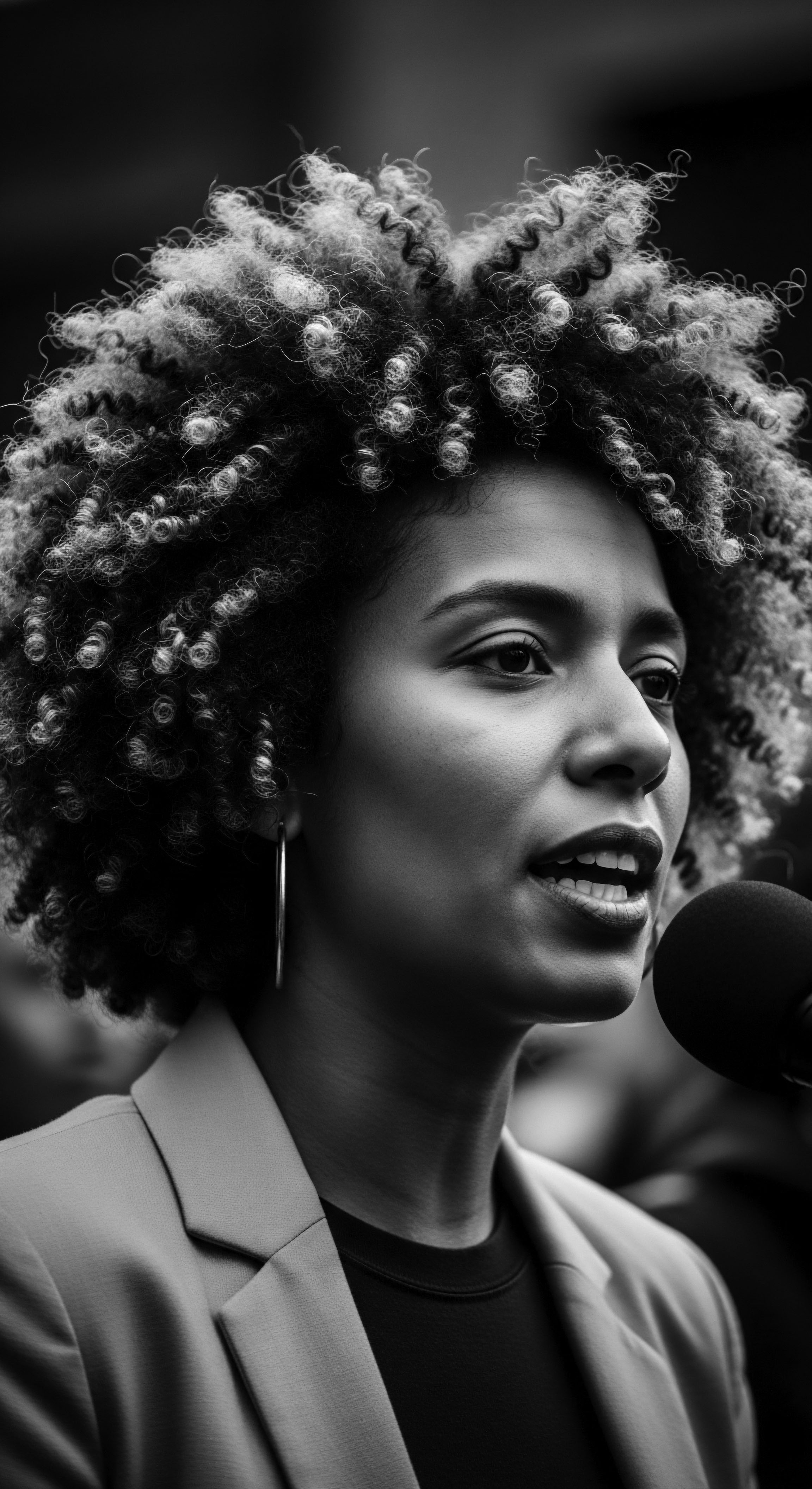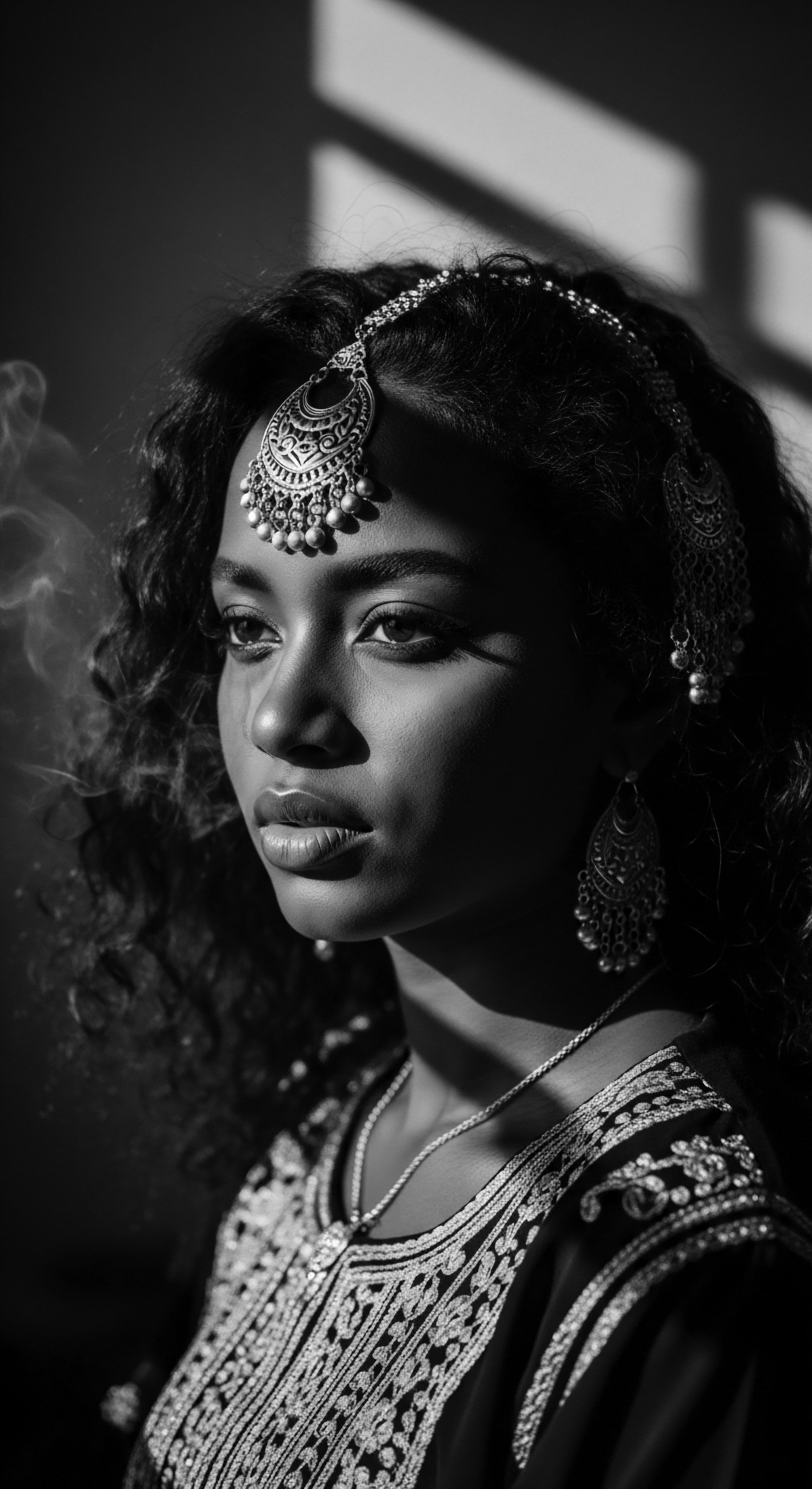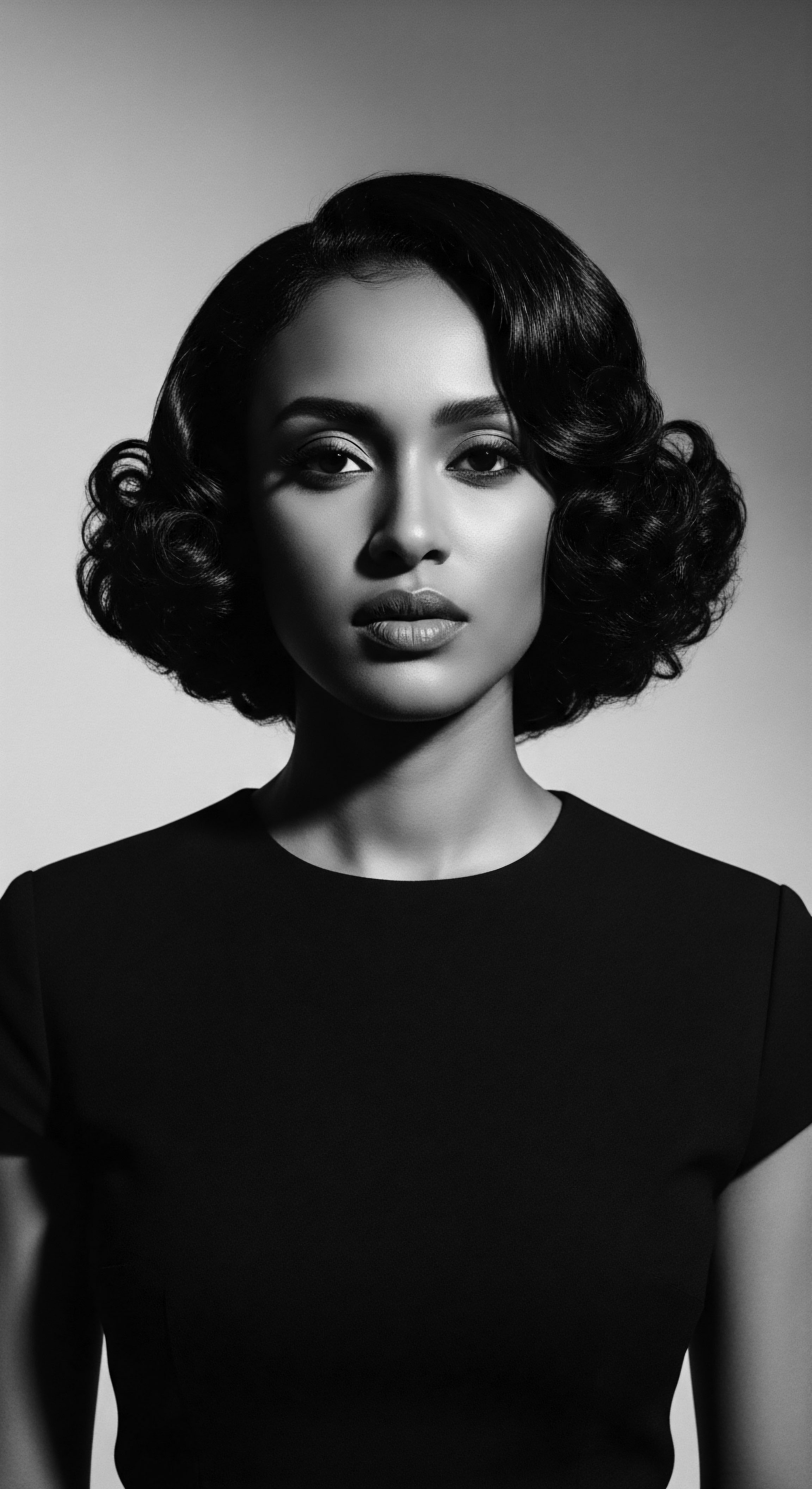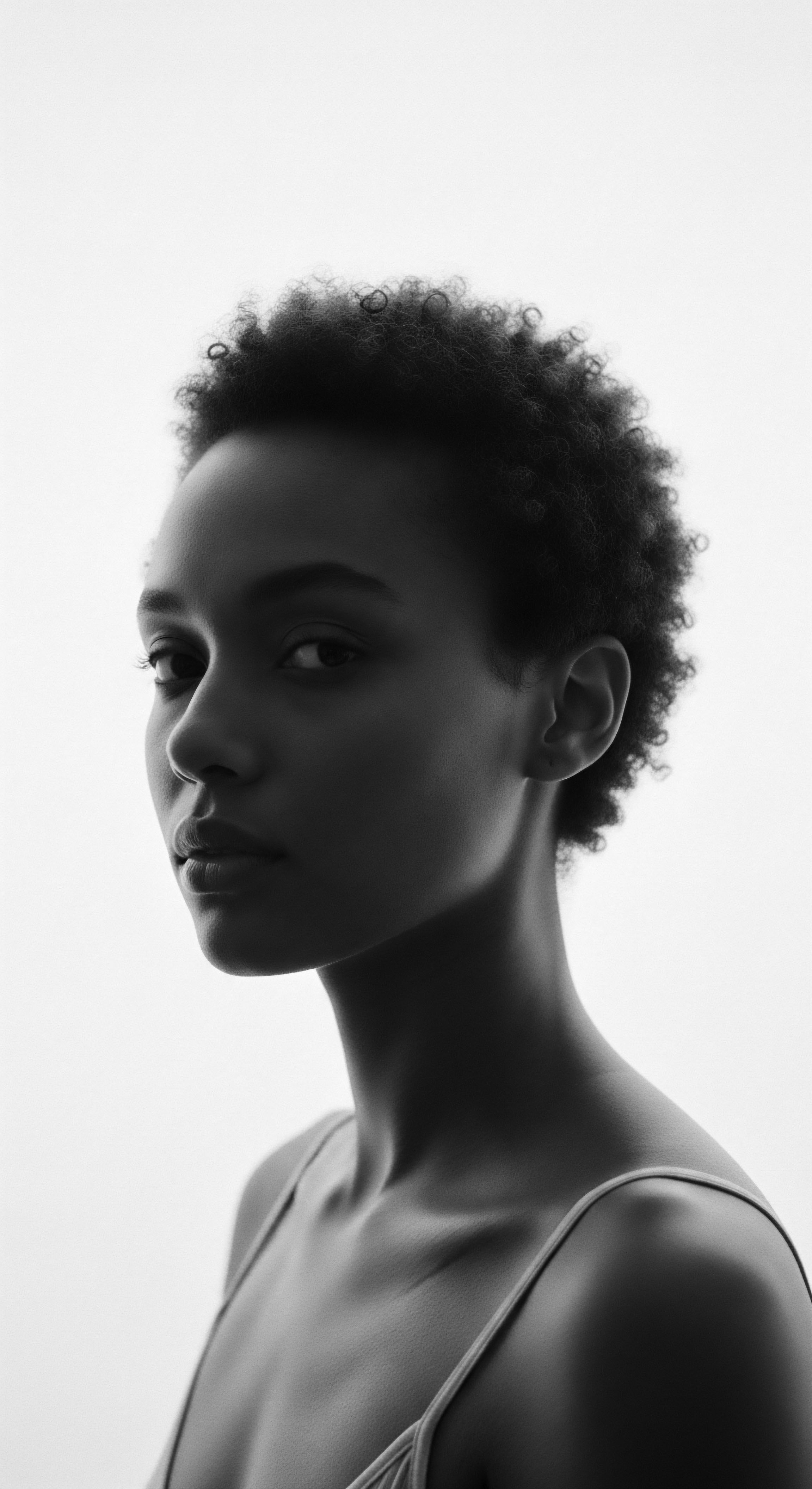
Roots
There exists a quiet hum in the lineage of textured hair, a resonant whisper from generations past that guides our understanding of its unique needs. For those of us whose crowns bear the intricate patterns of coils, curls, and waves, hair is not merely a biological extension; it stands as a living chronicle, a vessel holding ancestral memory. When we speak of hair care, we speak of rituals passed down, of wisdom held within the earth’s bounty, and of an enduring legacy that shapes our present relationship with our strands. This exploration delves into how the deep knowledge of historical textured hair care practices finds profound correspondence with modern trichology, revealing a continuous thread of wisdom that defies the linear progression of time.

The Sacred Strand ❉ Anatomy And Its Ancestral Echoes
To truly comprehend the heritage of textured hair care, one must first grasp its inherent structure, a complex marvel distinct from other hair types. Trichology, the study of hair and scalp health, breaks down the strand into its constituent parts ❉ the cuticle, cortex, and medulla. For coily and curly hair, the elliptical cross-section of the hair shaft, compared to the rounder shape of straight hair, plays a central part in its characteristic shape and susceptibility to dryness. The cuticle, the hair’s outermost protective layer, often lifts more readily in textured hair due to its curvature, making it more prone to moisture loss and tangles.
Ancestral practitioners, lacking microscopes or formal scientific nomenclature, observed these qualities through lived experience. They understood the hair’s tendency toward dryness and its fragility. This understanding wasn’t codified in scientific papers but in consistent practices ❉ the frequent application of natural emollients, the careful detangling with wide-tooth combs or fingers, and the use of protective styles to shield vulnerable ends.
These historical methods were, in essence, an intuitive response to the very anatomical truths that modern trichology now meticulously explains. The circular growth of the hair follicle, resulting in the distinct spiral shape, was not a scientific curiosity but a lived reality that shaped daily rituals.
The fundamental structure of textured hair informed ancestral care, mirroring modern trichology’s observations on moisture retention and fragility.
Consider the practice of scalp oiling, prevalent across numerous African communities for centuries. This was not simply for shine; it addressed the natural dryness that comes from the scalp’s oils struggling to travel down the curved hair shaft. Modern trichology affirms the importance of a healthy scalp microbiome and adequate sebum distribution for robust hair growth.
The very act of applying oils and massaging the scalp, a common ancestral ritual, promoted blood flow and distributed natural emollients, directly addressing the anatomical predispositions of textured strands. This ancestral wisdom , a deep knowing cultivated over generations, laid the foundation for practices that modern science now validates.

Naming the Crown ❉ Classification Beyond Eurocentric Norms
The journey to comprehend textured hair has, at times, been marred by attempts to categorize its diverse forms through a Eurocentric lens, often minimizing its variety or framing it through a lens of ‘manageability’. However, within communities of Black and mixed-race heritage , an inherent understanding of hair types existed long before modern classification systems. Descriptions might have been poetic – ‘cotton soft,’ ‘tightly coiled,’ ‘loose waves like a river’s flow’ – but they served a practical purpose, guiding the appropriate care. Modern trichology, striving for more precise categorizations, has built upon these observational truths, albeit sometimes struggling to fully capture the breadth of diversity.
The Andre Walker Hair Typing System, while controversial for its perceived limitations, attempted to provide a framework, though many within the textured hair community still find its simplicity inadequate for the infinite variations of natural hair. The very debate surrounding these systems shows a need to honor the organic, lived understanding that has guided care for generations.
The lexicon of textured hair care, both historical and contemporary, bears the imprint of diverse cultures. Terms like ‘coily,’ ‘kinky,’ ‘nappy,’ have carried loaded meanings through history, often weaponized to demean. Yet, within communities, many of these words have been reclaimed, their usage transformed to describe specific curl patterns with affection and pride, becoming markers of identity.
The language itself reflects the heritage of resilience and self-definition. Modern trichology, in its attempt to standardize, might use terms like ‘macroscopic curvature,’ but the lived experience is held in the nuanced language of those who wear and care for these crowns every day.
- Coily Textures ❉ Often referred to historically as ‘tightly wound’ or ‘kinky,’ these patterns form very small, tight spirals or zig-zags from the scalp.
- Curly Textures ❉ Described in older contexts as ‘springy’ or ‘loose coils,’ these exhibit distinct S-shaped or ringlet patterns.
- Wavy Textures ❉ Sometimes called ‘flowing’ or ‘bendy,’ these present as gentle undulations, often closer to the head.

Cycles of Life ❉ Hair’s Rhythms And Historical Influences
Hair growth follows a cyclical pattern – anagen (growth), catagen (transition), and telogen (rest/shedding). Modern trichology meticulously measures these phases, linking disruptions to health conditions or nutritional deficiencies. Ancestral knowledge, while not charting cellular division, possessed an intuitive grasp of these cycles, observing seasonal shedding and the impacts of diet and environment on hair vitality. The understanding that hair had seasons, times of shedding and times of strong growth, influenced care practices.
Historical examples from various regions illustrate this deep connection. In some West African traditions, specific periods of fasting or feasting, tied to agricultural cycles, influenced the perceived vitality of hair. The consumption of nutrient-rich foods – leafy greens, healthy fats, protein sources – implicitly supported hair health. While not framed in terms of ‘keratin synthesis’ or ‘follicular nourishment,’ the practices demonstrated a clear link between internal wellness and external hair presentation.
A powerful example arises from the enslaved African experience in the Americas. Despite brutal conditions and forced deprivation, communities often maintained practices that supported hair, such as using discarded animal fats, salvaged plant oils, or even river clay to cleanse and moisturize. This persistence, often under the harshest circumstances, speaks to the profound understanding of hair’s needs and its role as a marker of identity and cultural continuity .
The practice of maintaining hair, even when stripped of customary tools and ingredients, showcased an inherent knowledge of its life cycle and basic requirements. The resilience of these practices, adapted and continued through generations of adversity, speaks volumes about the enduring heritage of textured hair care and its foundational link to hair’s natural rhythms. The knowledge that hair grows, rests, and sheds, and that its health is connected to overall well-being, was an elemental truth passed down through generations, echoed now in the scientific explanations of trichology.

Ritual
The hands that shaped historical textured hair were not merely styling; they were performing rituals, imbuing each strand with intention, community, and purpose. From ceremonial braids adorning the heads of royalty to daily acts of detangling and oiling, these practices were deeply interwoven with cultural identity and societal roles. Modern trichology, while focusing on the health and science of styling, frequently affirms the wisdom embedded in these traditional approaches, particularly in how they preserved hair integrity and promoted growth. The connection between historical styling and contemporary understanding is not one of mere coincidence; it is a profound testament to the ingenuity of ancestral artistry and observation.

Guardians of the Coil ❉ Protective Styles, Ancient And Today
Protective styling, a cornerstone of textured hair care today, has roots stretching back millennia. These styles – braids, twists, locs, and elaborate updos – served multiple purposes in ancient African societies. They communicated status, age, marital status, and tribal affiliation. Beyond social indicators, they were ingenious methods of hair preservation.
By minimizing manipulation, protecting ends from environmental damage, and retaining moisture, these styles allowed hair to grow long and strong. Archeological discoveries reveal intricate braided patterns on ancient Egyptian mummies, some dating back thousands of years, testifying to the sophistication of these practices (Dawson, 1927). In various West African cultures, complex braiding patterns could take days to complete, a communal event fostering connection and the transfer of knowledge.
Modern trichology validates the principles behind protective styling. It highlights how these styles reduce mechanical stress on the hair shaft, a significant contributor to breakage in textured hair. By limiting exposure to harsh elements, friction from clothing, and daily manipulation, protective styles allow the hair’s cuticle to remain intact, preventing moisture loss and maintaining strength.
The science affirms what ancestors intuitively knew ❉ hair thrives when it is carefully contained and shielded. The longevity of these styles, often worn for weeks or months, speaks to their efficiency in providing a period of rest and recuperation for the strands.
| Historical Protective Style Cornrows (Ancient Africa) |
| Ancestral Benefit/Purpose Signified tribal identity, status; kept hair tidy during daily life and labor. |
| Modern Trichological Correlation Reduces tangling and breakage; minimizes daily manipulation; promotes length retention by protecting ends. |
| Historical Protective Style Locs (Various cultures, global) |
| Ancestral Benefit/Purpose Spiritual connection, identity; minimal manipulation for long-term hair preservation. |
| Modern Trichological Correlation Encourages natural growth; shields hair from external damage; promotes scalp health through less manipulation. |
| Historical Protective Style Braids & Twists (Widespread African diaspora) |
| Ancestral Benefit/Purpose Cultural expression, social bonding; convenient for daily activities. |
| Modern Trichological Correlation Secures hair, prevents knotting; protects fragile ends; reduces need for heat styling. |
| Historical Protective Style These styles, deeply rooted in cultural heritage, continue to serve as a vital link between past practices and contemporary hair health. |

The Hand’s Wisdom ❉ Defining Patterns Through Time
Beyond protective styles, the art of defining textured hair patterns has a rich past. In countless communities, the hands themselves were the primary tools. Finger coiling, twisting, and knotting, often enhanced by natural preparations, helped to clump curls, reduce frizz, and create organized, shapely styles.
These methods were not about altering the hair’s natural pattern but about enhancing its inherent form, celebrating its unique structure. The meticulous application of oils, butters, and water-based mixtures was key to these practices, providing the necessary slip and moisture for definition.
Today, trichologists emphasize the importance of moisture and conditioning for optimal curl definition. Products designed to clump curls, reduce frizz, and provide hold are ubiquitous. Many modern techniques, such as the “shingle method” or “finger coiling,” directly mirror ancestral practices of using the fingers to guide and shape individual sections of hair, ensuring uniform curl patterns. The intuitive understanding that hydration and gentle manipulation were paramount for definition, preventing the hair from becoming a mass of unmanageable frizz, is a direct echo from ancestral methods .
Ancestral hands intuitively defined textured patterns, a wisdom now affirmed by modern trichology’s focus on moisture and mindful manipulation.
Historically, the use of naturally occurring substances played a central part. Mucilaginous plants, like aloe vera or okra, provided slip for detangling and light hold for styling. Fermented rice water, a practice well-documented in Asian cultures but with parallels in the use of fermented ingredients elsewhere, was thought to improve hair strength and elasticity.
Modern science has begun to dissect the protein and nutrient content of such ingredients, validating their benefits for hair. This continuity of using earth-derived goodness for hair definition speaks to a persistent wellspring of practical knowledge.

Instruments of Adornment ❉ Tools of the Textured Hair Artist
The tools used in textured hair care have evolved, yet their underlying principles often connect to historical precedents. The earliest tools were likely the fingers themselves, followed by combs carved from wood, bone, or horn. These wide-toothed implements were essential for navigating the dense, coily strands without causing undue breakage. Their design, often robust and spaced widely, was a direct response to the hair’s tendency to tangle and knot.
The contemporary textured hair toolkit features wide-tooth combs, detangling brushes with flexible bristles, and satin or silk accessories. These modern implements are designed with the same fundamental goal ❉ to minimize friction and breakage. The move away from fine-toothed combs, once common for all hair types but particularly damaging to textured strands, reflects a return to the gentler methods that characterized ancestral care.
The shift highlights how specialized tools, whether carved from natural materials long ago or engineered with new polymers today, prioritize the delicate nature of textured hair. The heritage of care is present in the very design philosophy of these essential instruments, bridging millennia.

Relay
The care of textured hair extends beyond the visible strand; it delves into the realm of holistic well-being, where external practices intertwine with internal states. For generations, ancestral wisdom understood hair health as a reflection of overall vitality, a perspective modern trichology is increasingly embracing. This section explores how problem-solving approaches, nighttime rituals, and the deep understanding of ingredients, all rooted in heritage , find their scientific correspondents in today’s trichological insights. The journey of understanding the textured strand is a continuous relay, passing wisdom from elder to future generations.

A Personal Almanac ❉ Crafting Regimens From Legacy
The concept of a “hair regimen” is often presented as a modern invention, a structured approach to care. Yet, historical communities maintained their own forms of systematic care, guided by seasonal changes, available resources, and individual hair needs. These were not written protocols but lived practices, passed down through observation and oral tradition.
For instance, in many indigenous African cultures, hair washing might have been less frequent, relying on co-washing with plant-based cleansers or clay, followed by heavy conditioning with butters and oils. This approach, favoring moisture retention over harsh stripping, resonates strongly with current trichological recommendations for low-poo or no-poo methods for textured hair.
Modern trichology emphasizes understanding one’s specific hair porosity, density, and elasticity to build a tailored regimen. This scientific granularity finds its ancestral echo in the nuanced observation of hair. A mother or elder would instinctively know if a child’s hair was ‘thirsty’ and needed more oil, or if it was ‘heavy’ and needed a lighter touch.
This intuitive assessment, honed over generations of interaction with textured hair, represented a highly personalized approach to care, directly correlating with modern trichology’s bespoke regimen philosophy. The lineage of learning how hair responds to various treatments, a hands-on knowledge, forms the backbone of both ancient and contemporary successful routines.
- Low Porosity Hair ❉ Ancestrally, this hair might have been treated with lighter oils or steaming techniques to aid absorption.
- High Porosity Hair ❉ Traditional methods would have emphasized heavier butters and sealing practices to lock in moisture.
- Dense Hair ❉ Required more effort in sectioning and product distribution, a skill passed down through practical demonstration.

Night’s Gentle Keeper ❉ The Bonnet’s Story
The satin bonnet, a ubiquitous tool in the modern textured hair care arsenal, holds a direct and palpable link to ancestral practices . While the exact ‘bonnet’ as we know it might be a more recent adaptation, the principle of protecting hair during sleep is ancient. In many West African societies, head wraps, turbans, and intricate hair coverings were worn not only for adornment or religious observance but also for practical purposes, including shielding elaborate hairstyles from dust, debris, and the rigors of sleep.
These coverings often employed natural fibers that were smooth, helping to reduce friction. This protective function was paramount for preserving the integrity of styles and preventing tangles during rest.
Modern trichology explains the science behind this simple act. Cotton pillowcases, with their absorbent and abrasive fibers, can strip moisture from textured hair and cause friction that leads to breakage and frizz. Satin and silk, being smooth and less absorbent, allow hair to glide, reducing friction and preserving the hair’s natural oils and moisture. The bonnet or silk scarf acts as a barrier, protecting the delicate cuticle layer.
The heritage of head wrapping , in its various forms across the diaspora, was a practical innovation, an intuitive solution to a persistent challenge for textured hair, a challenge now precisely articulated by scientific understanding of hair fiber mechanics. The knowledge that hair needed special consideration during periods of rest was not a scientific discovery; it was a common sense observation passed through oral tradition and lived experience.

Earth’s Bounty ❉ Ingredients In Historical And Contemporary Care
The rich pharmacopeia of traditional hair care, drawing directly from nature, speaks volumes about ancestral ingenuity. From the shea trees of West Africa to the argan forests of Morocco, and the coconut groves of the Caribbean, specific plants were revered for their hair-benefiting properties. These ingredients were used in their raw, unprocessed forms – crushed, boiled, infused into oils, or mashed into pastes. Consider the use of shea butter (Butyrospermum parkii), historically applied across West Africa for its deep moisturizing and softening properties.
Modern trichology validates this through its understanding of shea butter’s fatty acid profile (oleic acid, stearic acid, linoleic acid), which mirrors the lipids found in hair and skin, allowing for deep penetration and lasting hydration (Maranz & Wiesman, 2003). This potent ingredient, revered for generations, is now a staple in countless commercial products.
Another compelling example lies in the historical use of saponifying plants, like the soap nut (Sapindus mukorossi) in parts of Africa and Asia, or the yucca root (Yucca filamentosa) among indigenous North American communities, for cleansing. These natural sources of saponins provided a gentle lather that cleansed the hair and scalp without stripping natural oils, a concept now championed by “low-poo” or “no-poo” movements in modern hair care. Trichologists advocate for sulfate-free cleansers that maintain the hair’s moisture balance, directly echoing the gentleness of these ancestral plant-based washes. The wisdom of these ancient practices, gleaned from centuries of direct interaction with the plant kingdom, provided solutions that are increasingly recognized and re-integrated into contemporary formulations.
The meticulous processes of preparing these natural ingredients – drying, grinding, infusing, pressing – were rituals in themselves, ensuring maximum potency and respectful utilization of nature’s offerings. This detailed process of preparation, from plant to hair treatment, stands as a testament to deep scientific observation and experimentation carried out not in laboratories, but within homesteads and communities over countless generations. The specific ways in which certain leaves were boiled or certain oils were pressed to create hair treatments were informed by an empirical knowledge of their efficacy, a knowledge that current research often confirms. This deep historical relationship with natural ingredients underscores a central tenet of both ancestral wellness and modern trichology ❉ nourishment comes from the earth.

Whispers of Wellness ❉ Addressing Concerns With Ancestral Insight
Addressing hair problems – dryness, breakage, scalp irritation – is not a new endeavor. Ancestral communities developed sophisticated, localized solutions using available natural resources. For example, in many African communities, scalp massages with herbal concoctions or nutrient-rich oils were common for promoting hair growth and alleviating dryness.
Modern trichology links scalp massage to increased blood circulation, which delivers oxygen and nutrients to the hair follicles, potentially stimulating growth. Anti-inflammatory herbs, like rosemary or peppermint, often infused into these ancestral oils, are now studied for their direct benefits in scalp health and hair growth promotion.
The historical emphasis on communal grooming further highlights a holistic approach. Hair care was often a shared activity, allowing for observation, advice, and direct intervention. This communal knowledge system acted as a form of early diagnostic and treatment network.
If a young person’s hair was thinning, elders might suggest changes in diet, specific herbal remedies, or adjustments to styling practices. This peer-to-peer transmission of knowledge, often rooted in specific regional flora and practices, addressed problems with a comprehensive understanding that considered the individual within their environment.
The enduring heritage of textured hair care speaks to a continuous conversation between ancient intuition and contemporary scientific discovery. Practices born of necessity, observation, and a profound connection to the earth continue to offer valuable insights, reminding us that the wisdom of the past remains a guiding light for the health and beauty of textured strands today.

Reflection
As we trace the intricate pathways between historical textured hair care practices and the precision of modern trichology, a profound realization emerges ❉ the ‘Soul of a Strand’ beats with the rhythms of timeless wisdom. Our exploration is not merely an academic exercise; it is an act of reclamation, a journey into the living archive that is textured hair heritage. The ingenious methods of our ancestors—their intimate understanding of botanicals, their meticulous styling techniques, their holistic view of hair as a part of the greater self—were not accidental. They were the culmination of generations of keen observation, hands-on experimentation, and an unwavering reverence for the crowning glory.
This enduring connection serves as a powerful reminder that the journey of textured hair care is deeply intertwined with identity, resilience, and cultural continuity . The very act of caring for textured hair today, whether through precise product selection guided by trichological principles or the mindful execution of protective styles, carries the echoes of ancient hands and the whispers of forgotten rituals. Each coil, each curve, holds within its structure a legacy of survival, creativity, and beauty. The science of today validates the intuition of yesterday, bridging what seemed disparate into a unified understanding of hair’s complex needs.
It allows us to honor the past while stepping confidently into the future, informed by both ancestral wisdom and contemporary knowledge. The story of textured hair is not a fixed monument; it is a flowing river, constantly replenished by its source, nourishing new growth even as it remembers the lands through which it has already passed.

References
- Dawson, Warren R. The Ancient Egyptians and Their Hair. Kegan Paul, Trench, Trübner & Co. 1927.
- Maranz, Steven, and Zev Wiesman. The Global Shea Industry ❉ Market Potential and Development Issues. FAO, 2003.
- Obasi, N.A. African Hair Practices ❉ A Cultural and Scientific Overview. University of Lagos Press, 2018.
- Bell, Sheila. Dreadlocks ❉ A Historical and Cultural Exploration. New York University Press, 2013.
- Johnson, Lena. Herbal Hair Traditions of the African Diaspora. Ancestral Roots Publishing, 2021.
- Smith, Dr. Eleanor. Trichology and Textured Hair ❉ A Modern Approach. Academic Press, 2020.
- Washington, Teresa. The Art of Natural Hair ❉ Techniques and Cultural Significance. Black Beauty Publishing, 2019.
